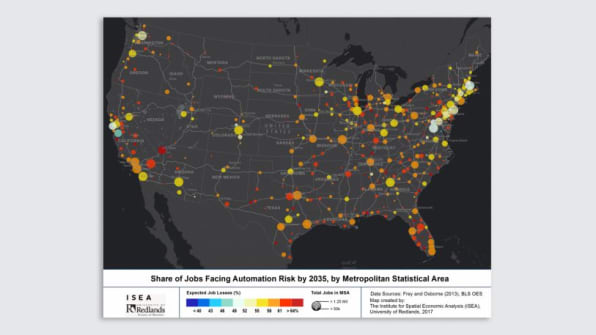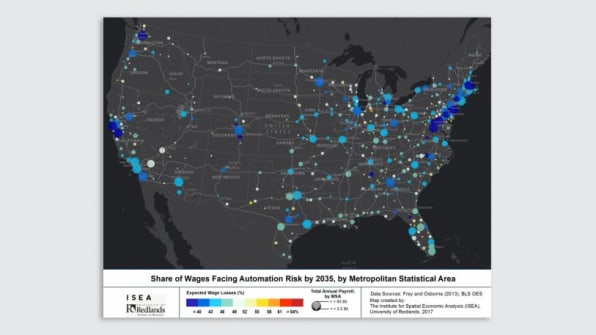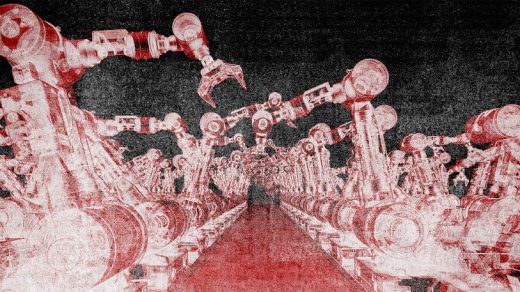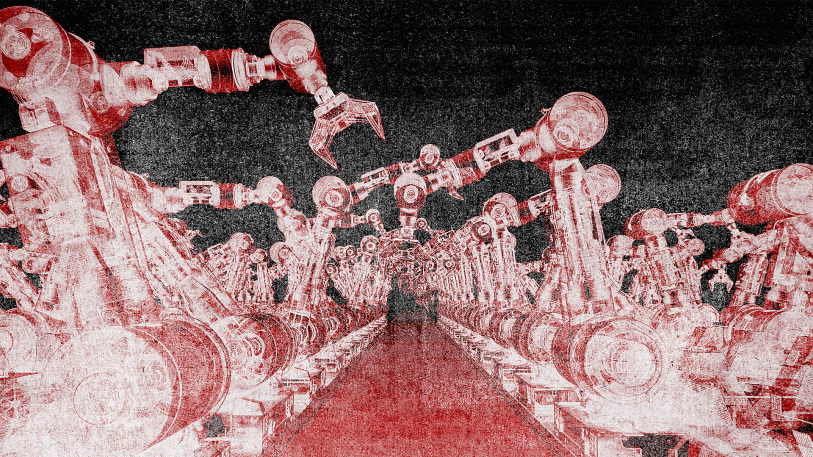Do You Live On The Front Lines Of Automation?
If you live in Las Vegas, El Paso, or Louisville, there’s a particularly good chance that your job could be taken by a robot in the next two decades.
Using data from a 2013 Oxford study that found that nearly half of American jobs are at risk from automation–from truck driving and telemarketing to legal assistants–a new study maps out which cities are likely to lose the most jobs. (The next phase of the research will look at how the risk affects people differently based on age, race, educational level, and other demographic factors, and will break down data further by ZIP code).
Researchers at the Institute for Spatial Economic Analysis at the University of Redlands wanted to make the risk tangible and understandable through the new study.

“If I tell you that 50% of the jobs in the United States are at risk from automation right now, that’s a very different idea than saying, ‘Hey, here in San Bernardino, we’re facing x-percent automation risk,” Johannes Moenius, the institute’s director, tells Fast Company. “People know the social fabric, they know the types of jobs that exist here. Then it hits home, and people understand we need to do something. We can’t just wait for this to happen.”
While the last wave of automation took away some middle-class work–particularly factory and mining jobs–the current wave of automation will hit lower-income jobs hardest. Robots are already beginning to brew coffee, flip burgers, and bake pizza. Agricultural robots can pick strawberries and weed carrot fields. As many as 1.7 million truck driver could be replaced by self-driving trucks, as one of the early casualties of new automation.
“What we’re seeing is this wave of automation is going to specifically affect the less educated,” Moenius says. “There are lots and lots of them. Possibilities that we’ve thought about in recent years are now hitting the range where they become economically feasible. It’s just so incredibly fast, and it’s affecting so many jobs at a time.”
Just because the technology exists doesn’t guarantee that it will be adopted, but the map looks at what is possible. “We have to be very clear, being at risk of automation doesn’t mean that a job necessarily gets automated,” he says. “I can’t imagine that we suddenly have all poker dealers or all waiters suddenly replaced by robots. High-end restaurants will still have waiters because that’s part of the experience. But this tells you what’s the technical possibility. And specifically on the lower end of the food chain, whatever’s going to be possible to get automated, will get automated.”
The study maps the Oxford research about which jobs are most at risk onto employment data from the Bureau of Labor Statistics for 100 metropolitan areas in the U.S. Bubbles that are more red indicate a higher share of jobs at risk; the size of each bubble indicates how many workers were employed in 2016. In the Las Vegas metropolitan area, 65.2% of jobs are at risk. El Paso follows at 63.9%.

Three categories of jobs make up around half of the possible losses in the largest metropolitan areas: office and administrative support, food preparation and serving, and sales-related jobs. In certain areas, such as Riverside, California and Louisville, transportation jobs also make up a large portion of the losses.
Fighting automation won’t work, Moenius says. “If we don’t automate, China will do it for us, and we’ll have wage-reversal.” Instead, governments, industries, and educational institutions should be thinking about how to prepare, including retraining programs.
“I don’t think there is a one-size-fits-all solution to this,” he says. “We really believe that each city will have to find its own way.” As cities rethink employment, they will also likely have to rethink land use. Moenius points out that in his own area, Southern California’s Inland Empire, people live next to the warehouses and freeways that support a logistics economy; as work shifts, that layout should also change.
If your own job is at risk (this handy calculator will help you understand), you can work on learning new skills. “Initiatives that try to foster stem education really go in the right direction, because if you speak math then you can learn how to deal with problems that we don’t even know are problems yet,” he says. “Problem-solving, spatial thinking, having an understanding of multidisciplinary issues–these are things that everyone who has to make a decision of what I should be educated in now [should think about].”
(51)



